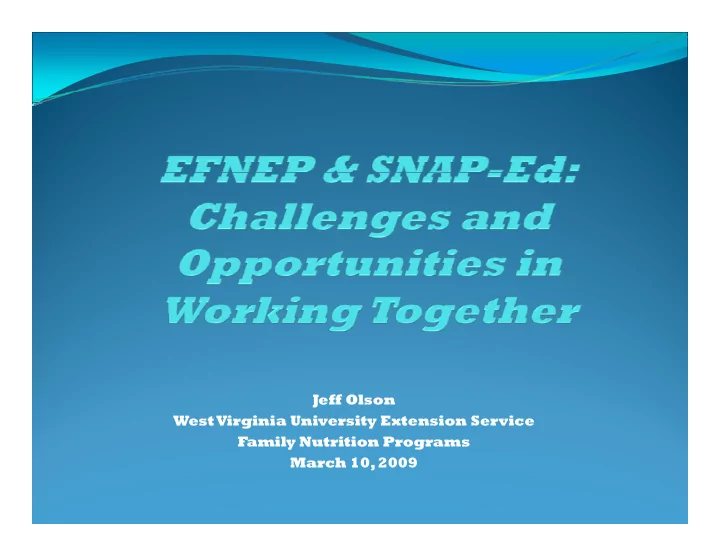

Jeff Olson West Virginia University Extension Service Family Nutrition Programs March 10, 2009
Hancock Brooke Ohio Marshall Monongalia Wetzel Morgan Pleas- Marion Berkeley Tyler Preston ants Mineral Jeff- Taylor Dodd- Harrison Hampshire erson Wood ridge ridge Grant G t Ritchie Ri hi Barbour Tucker Wirt Hardy Lewis Cal- Gilmer Upshur houn Jackson Randolph Mason Roane Braxton Pendleton Putnam Webster Clay Cabell Kanawha Nutrition Outreach Instructors Nicholas Pocahontas by Target Audience Wayne Lincoln Boone Fayette Youth and Adult Greenbrier Youth Mingo Logan Raleigh Adult Wyoming Sum- Monroe mers mers 51 I 51 Instructors serving 43 Counties t t i 43 C ti Mercer McDowell
Family Nut t o Nutrition Programs PROJECTS Adult Summer WV Research Youth Projects Food Nutrition Projects Projects Service Network Program
Family Nutrition Programs g BUDGETS Summer Fees F&A CBI WVU SNAP-Ed EFNEP Food (Indirects) Grant Foundation Service Program
Family Nutrition Programs Annual Dollars Expanded Summer Fees Food CBI WVU F&A Food & Food Stamp Grant Foundation (Indirects) Nutrition Service Nutrition Education Program Education Program (FSNE) (EFNEP) ($10,000) ($60,000) ($960,000) ($120,000) ($1000) ($5.2 Million) ($20,000)
Why not work together? Competition for participants 1. Competition for state/local investments Competition for state/local investments 2. 2. “THEY” do it “their” way. 3. Interpretation of policies limit opportunities to work te p etat o o po c es t oppo tu t es to wo 4. 4. together. Programmatic limitations. 5.
Why work together? (Budget) � EFNEP � Con: Funding is limited � Pro: Funds can carryover � SNAP Ed � SNAP ‐ Ed � Con: Funds expire September 31st � Pro: Funds can increase (depending on state/local share) � Pro: Funds can increase (depending on state/local share)
Why work together? (Program) � EFNEP � Significant results at individual and interpersonal level of influence (SE Model) f i fl (SE M d l) � SNAP Ed � SNAP ‐ Ed � Flexibility to engage in partnerships and target multiple levels of SE Model
CDC’s Social ‐ Ecological Model
Why work together? (Needs) � EFNEP � EFNEP � Assets: � Formula Funding Formula Funding � Model of Success � Model of advocacy � SNAP ‐ Ed � Assets: A t � Size of budgets � History of networking y g � Leverage interest
RESULTS � Seamless operation at local/county level between ENFEP & SNAP ‐ Ed � Opportunity to expand programming and sustain growth growth � � Increased administrative burden to maintain Increased administrative burden to maintain integrity and accountability
FINDINGS � Change takes a generation � Collaboration enhances the results (Outcome Evaluation) of direct delivery Evaluation) of direct delivery � � Developed model of collaboration Developed model of collaboration
Association of State Nutrition Association of State Nutrition Network Administrators The purposes of the Association are: � To strengthen leadership skills and competencies of state administrators and SNAP ‐ Ed Implementing Agency coordinators. p g g y � To assist states with developing, implementing and evaluating approaches to social marketing within SNAP. � To assist states with implementing unique approaches to developing state/local partnerships and collaborations within SNAP ‐ Ed, including: state/local partnerships and collaborations within SNAP Ed, including: � Public and private Agencies. � Government and non ‐ government Offices. � Non profits and for profits Organizations. � d. To share information broadly with the SNAP community. � e. To provide a forum for state Nutrition Network leaders to identify and share best practices of nutrition education for low ‐ income families and youth. y
Mi Mission Statement i S � ASNNA is a group of nutrition education leaders who � ASNNA is a group of nutrition education leaders who work together to promote communication between federal and state agencies; promote social marketing g g within nutrition education; serve as a nation ‐ wide resource for nutrition education, networking expertise and partnership development within SNAP expertise, and partnership development within SNAP ‐ Ed; and advance successful practices that lead to the incorporation of the Dietary Guidelines for Americans , p y f specifically among SNAP ‐ Ed eligible individuals and communities.
Vision � ASNNA is an actively involved group of SNAP ‐ Ed administrators that: � Develops leadership for the future of nutrition education. D l l d hi f h f f i i d i � Recognizes and promotes excellence in SNAP ‐ Ed � Advocates and promotes best practices for SNAP Ed � Advocates and promotes best practices for SNAP ‐ Ed, including social marketing. � Promotes collaboration building and partnering efforts to support the nutrition education mission of the USDA and other agencies and organizations as appropriate.
Recommend
More recommend